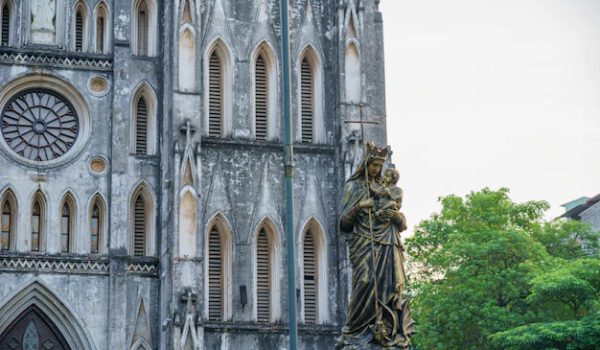
In a land area of 4,656 square kilometers, the archdiocesan territory covers most of Ha Noi city, whole province of Ha Nam and part of provinces of Nam Dinh and Hung Yen. The capital based in the middle of Hong River delta is the largest in terms of territory in the country.
In 1010, King Ly Thai To moved his imperial palace to Thang Long or flying dragon. It served as a center for economy, culture, education, politics and religions. Thang Long was named Ha Noi in 1831.
The 1,000 year-old capital is formed by the town of Son Tay and 27 districts in a land of 3,324.92 square kilometers.
As year end 2016, the total population of the archdiocese was 8,651,000. 26 percent of local householders have areas of houses below 7 square meters per person.
Internal migrant workers account for 11 percent of the population. Their monthly per capital income is two million dong (US$100).
Ha Noi archdiocese is on of oldest dioceses and is seen mother of many northern dioceses.
Tay Dang Ngoai (West Tonkin) vicariate was separated from Tonkin vicariate in 1679. In 1753 the vicariate had 131,727 Catholics.
The vicariate produced vicariates of Vinh in 1846, Hung Hoa in 1895, Phat Diem in 1901 and Thanh Hoa in 1924.
It was named Ha Noi vicariate in 1924 and elevated to Ha Noi archdiocese in 1960, when the Vietnam Church hierarchy was established. Its first Vietnamese archbishop was Archbishop Joseph Marie Trinh Nhu Khue.
Since 1945, when Ho Chi Minh delared independence, the local Church's properties were confiscated and facilities were closed. Local clergy was isolated and threatened. Church activities were limited.
After French troops were defeated by communists in 1954, many local Catholics moved to the south, those who stayed were threatened and prevented from schools and hospitals. Many gave up their faith or stopped faith practice.
The local Church lacked clergy since many priests were imprisoned or under housearrest. In 1974, the archdiocese had 23 priests serving 160,000 Catholics.
The Saint Joseph Major Seminary was allowed to recruit nine students in 1973. Now it gives priestly formation to students from eight northern dioceses.
Archbishop Khue wore red hat in Rome in 1976: He was the first Vietnamese cardinal.
Under the communist rule for decades, many Catholics give up their faith practice. The archdiocese still lack resident priests at many local parishes.
Now the archdiocese focuses on training clergy, Religious and lay leaders. It plans to build a cultural and faith center. It also plans to establish clinics and centers for orphans, people with physical disabilities, street people, elderly people without relatives and unwed pregnant women.
Its titular is the feast of Saint Joseph on March 19.
Based in the middle of northern Vietnam, the capital is connected with other parts of the country by land, air and sea transport. Noi Bai International Airport is 35 kilometers away from the downtown. Trains also run from Ha Noi to Beijing.
Main vehicles include bicycles, motorbikes, buses, boats, trains and airplanes.
Before Tet festivals, migrant workers have difficulty taking buses, trains boats and airplanes to return to their homes in other places.
The annual per capita income of Ha Noi was 3.321 million dong in 2009.
However, those who have monthly per capita income of 750,000-1,000,000 dong (US$37.5-50) in urban areas and 550,000-750,000 dong (US$27.5-37.5) in rurual areas number 210,000 householders.
Migrant workers from neighboring provinces come to look for jobs in the city, so the population density in the city is very high. Traffic jam is a biggest problem there.
The city is known for 36 old streets with various goods or services and trade villages.
The climate is typical of tropical climate. The summer is hot and rainy and the winter is cold and dry. The annual solar radiation is 122.8 kcal/cm2. The average annual temperature is 15-29 degrees Centigrade and annual rainfall is 1,800 millimeters.
The area has four seasons - spring, summer, fall and winter
Literacy rate (simple literacy) is 98 percent of the population. Ha Noi is one of three cities having highest literacy rate in the country's 63 cities and provinces. It is home to national educational centers.
Followers of Buddhism, Christianism, Muslim and indigenous faiths. Buddhism is considered the oldest there. In the past it was the national religion.
Ha Noi is the meeting point between Easter and Western cultures. It has been affected by Chinese culture. China governed the country over 1,000 years. It is known for ancient Buddhist temples.
Later French colonials brought Western lifestyles, architectures, culture, music, poems, painting, films, photography, and so on to local people. Many French-styled architectural buildings and bridges still exist.
The capital is known for local traditional festivals, folklores and religious traditions.